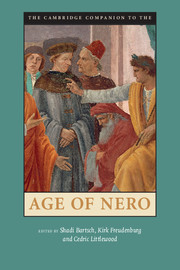Book contents
- The Cambridge Companion to the Age of Nero
- The Cambridge Companion to the Age of Nero
- Copyright page
- Contents
- Illustrations
- Contributors
- Acknowledgments
- Timeline of Events
- Abbreviations
- Julio-Claudian Family Tree
- Additional material
- Introduction: Angles on an Emperor
- Part I Nero’s World
- Part II Neronian Literature
- Part III Neronian Seneca
- Part IV Nero’s Monumental Rome
- Part V The Neros of Reception
- Part VI After the Last Laugh
- Appendix Nero’s Image: The Four Portrait Types
- General Bibliography
- Index
- References
General Bibliography
Published online by Cambridge University Press: 16 November 2017
- The Cambridge Companion to the Age of Nero
- The Cambridge Companion to the Age of Nero
- Copyright page
- Contents
- Illustrations
- Contributors
- Acknowledgments
- Timeline of Events
- Abbreviations
- Julio-Claudian Family Tree
- Additional material
- Introduction: Angles on an Emperor
- Part I Nero’s World
- Part II Neronian Literature
- Part III Neronian Seneca
- Part IV Nero’s Monumental Rome
- Part V The Neros of Reception
- Part VI After the Last Laugh
- Appendix Nero’s Image: The Four Portrait Types
- General Bibliography
- Index
- References
- Type
- Chapter
- Information
- The Cambridge Companion to the Age of Nero , pp. 359 - 395Publisher: Cambridge University PressPrint publication year: 2017

